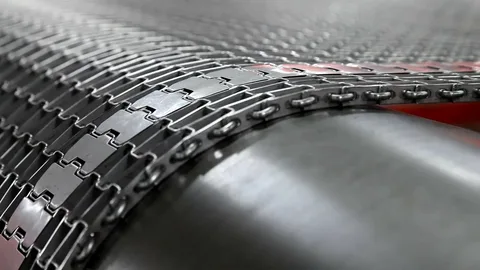A metal conveyor is a mechanical system that utilizes a continuous metal belt or chain to transport materials from one location to another. They are the workhorses of countless industries, seamlessly integrating into production lines to efficiently move a wide range of materials, from delicate food items to heavy machinery components.
Types of Metal Conveyors
The world of metal conveyors is vast and versatile, with each type designed to excel in specific applications. Here’s a closer look at some of the most common varieties:
-
Roller Conveyors: These workhorses feature a series of rollers mounted on a sturdy metal frame. Ideal for conveying boxes, pallets, and other items with flat, stable bases, roller conveyors can be gravity-fed or powered for inclined applications.
-
Belt Conveyors: As the name suggests, belt conveyors utilize a continuous belt made of metal, plastic, or rubber to transport materials. They offer excellent versatility for conveying a wide range of materials, from bulk solids to individual parts.
-
Wire Mesh Conveyors: These conveyors employ a flexible mesh belt woven from metal wires. Often used in applications requiring drainage, ventilation, or sifting, wire mesh conveyors excel in food processing, pharmaceuticals, and metalworking industries.
-
Overhead Conveyors: Suspended from the ceiling, overhead conveyors provide a space-saving solution for transporting materials throughout a facility. They come in various configurations, including chain conveyors, trolley conveyors, and power-and-free conveyors.
Understanding Metal Conveyor Components
Metal conveyors are comprised of several key components, each playing a crucial role in ensuring smooth operation:
-
Frame: The frame provides the structural support for the entire conveyor system. Made from sturdy steel or aluminum, it must be able to withstand the weight and impact of the materials being conveyed.
-
Belt or Chain: This is the heart of the conveyor, continuously moving to transport materials. The choice of belt or chain material depends on factors like the type of material being conveyed, weight capacity, and operating temperature.
-
Drive System: The drive system provides the power to move the belt or chain. This can be a motor, gearbox, or pulley system, depending on the conveyor type and capacity.
-
Idlers and Rollers: These components support and guide the movement of the belt or chain. Idlers are typically free-spinning wheels, while rollers can be powered to aid in material movement on inclines.
-
Controls: Modern metal conveyors often incorporate control systems for regulating speed, direction, and stopping the conveyor. These controls can be manual or automated, integrated into a larger production line control system.
Benefits of Using Metal Conveyors
Metal conveyors offer a multitude of advantages for industrial applications, making them a popular choice across various industries. Here are some of the key benefits:
-
Efficiency: Metal conveyors automate the transportation of materials, significantly improving production efficiency and throughput.
-
Versatility: With a wide range of types and configurations available, metal conveyors can handle a vast array of materials, shapes, and sizes.
-
Durability: Constructed from robust metal components, metal conveyors are built to withstand demanding industrial environments.
-
Scalability: Metal conveyor systems can be easily customized and expanded to meet changing production needs.
-
Safety: Modern metal conveyors often incorporate safety features like guards and emergency stops to minimize operator risks.
Selecting the Right Metal Conveyor
Choosing the ideal metal conveyor for your application requires careful consideration of several factors. Here are some key questions to ask yourself:
-
What type of material will be conveyed? Size, shape, weight, and material properties all play a role in conveyor selection.
-
What is the required capacity? The conveyor must be able to handle the volume of materials you need to transport.
-
What is the desired speed and direction of travel? Consider if the conveyor needs to be variable speed or unidirectional.
-
What is the layout of your facility? The available space and desired conveyor path will influence the type and configuration you choose.
Metal Conveyors: Applications Across Industries
Metal conveyors are ubiquitous throughout the industrial landscape, seamlessly integrating into countless processes. Here’s a glimpse into their diverse applications across various sectors:
-
Manufacturing: On assembly lines, metal conveyors efficiently transport parts and components between workstations, ensuring a smooth flow of materials. From automotive manufacturing to electronics assembly, metal conveyors are the backbone of efficient production.
-
Food and Beverage: Ensuring hygiene is paramount in food processing. Metal conveyors made from stainless steel, a non-porous and corrosion-resistant material, are ideal for conveying food items. They can be designed for washing and sanitization to maintain the highest food safety standards.
-
Warehousing and Distribution: Metal conveyors play a crucial role in efficiently moving goods within warehouses and distribution centers. Pallet conveyors, for instance, handle heavy palletized loads, while roller conveyors expedite the movement of boxed items.
-
Chemical and Pharmaceutical Industries: Metal conveyors are essential for transporting various materials in these sectors. Wire mesh conveyors are often used for materials requiring drainage, while enclosed belt conveyors can be used for sensitive or hazardous materials.
-
Waste and Recycling: Metal conveyors play a vital role in modern waste management facilities. They can handle everything from bulky recyclables to heavy industrial waste materials, ensuring efficient sorting and processing.
Customizable Metal Conveyor Solutions
The beauty of metal conveyors lies in their inherent adaptability. Manufacturers offer a wide range of customization options to cater to specific needs. Here are some examples:
-
Length and Width: Metal conveyors can be tailored to fit the available space within your facility, ensuring optimal use of floor area.
-
Inclines and Declines: Conveyors can be designed with inclines or declines to move materials vertically, creating efficient multi-level production lines.
-
Transfers and Diverters: These components allow materials to be transferred between conveyors or diverted to different paths within a production line.
-
Integration with Automation Systems: Modern metal conveyors can be seamlessly integrated with automated control systems, enabling precise control over speed, direction, and material handling.
Metal Conveyor Maintenance Tips
Proper maintenance is crucial to ensuring the smooth operation and longevity of your metal conveyor system. Here are some key tips:
-
Regular Cleaning: The cleaning frequency depends on the materials being conveyed and the operating environment. Regular cleaning helps prevent material buildup and ensures optimal performance.
-
Lubrication: Lubricating bearings and other moving parts as per the manufacturer’s recommendations minimizes friction and wear, extending the lifespan of the conveyor.
-
Belt or Chain Inspection: Regularly inspect the belt or chain for signs of wear and tear, such as cracks, tears, or excessive stretching. Replace worn components promptly to avoid breakdowns.
-
Tension Adjustment: Over time, belts and chains can loosen, affecting performance. Maintain proper belt or chain tension as specified by the manufacturer.
-
Safety Checks: Ensure all safety guards and interlocks are functioning correctly to minimize the risk of accidents.
By following these simple maintenance tips, you can keep your metal conveyor system operating smoothly and efficiently for years to come.
Metal Conveyor FAQs
1. What are the different types of metal conveyor belts?
Metal conveyor belts come in various options, each suited for specific applications. Here are a few common types:
- Stainless Steel: Ideal for food processing and pharmaceutical applications due to its corrosion resistance and ease of sanitation.
- Carbon Steel: A cost-effective option for general-purpose conveying applications.
- Plastic Belting with Metal Mesh: Provides a combination of strength and flexibility, often used in applications requiring drainage or product visibility.
2. Can metal conveyors handle heavy loads?
Absolutely! Metal conveyors are designed to handle a wide range of weight capacities. Heavy-duty conveyors can accommodate massive loads, such as machinery components or palletized goods.
3. Are metal conveyors noisy?
Noise levels can vary depending on the conveyor type, size, and operating speed. However, modern metal conveyors often incorporate noise-reduction features like belt materials and bearing designs to minimize noise generation.
4. How much does a metal conveyor cost?
The cost of a metal conveyor depends on several factors, including size, capacity, type, and any customization requirements. Generally, simpler conveyors are more affordable, while complex systems with specialized features will have a higher price tag.
5. Where can I buy a metal conveyor?
Numerous reputable metal conveyor manufacturers and distributors operate globally. Conduct thorough research to find a supplier that offers the specific type and features you require for your application.
Metal Conveyors: Unveiling the Future
The future of metal conveyors is brimming with exciting possibilities, driven by advancements in technology and a growing focus on efficiency and sustainability. Here’s a peek into what lies ahead:
-
Smart Conveyors: The integration of sensors and artificial intelligence (AI) will transform metal conveyors into intelligent systems. These smart conveyors will collect real-time data on material flow, predict maintenance needs, and optimize performance for maximum efficiency.
-
Advanced Materials: Research and development in material science will lead to the creation of even stronger, lighter, and more corrosion-resistant materials for metal conveyor components. This will enhance durability, reduce weight for easier handling, and improve suitability for diverse environments.
-
Energy Efficiency: As sustainability becomes a top priority, manufacturers will focus on developing metal conveyors with energy-efficient motors and drive systems. This will minimize energy consumption and reduce the environmental impact of conveyor operations.
-
Modular Design: The future promises even greater modularity in metal conveyor design. This will allow for easier customization, faster assembly, and simpler reconfigurations to adapt to changing production needs.
-
Collaborative Robots (Cobots): The rise of cobots will see them working seamlessly alongside metal conveyors. Cobots can perform tasks like loading and unloading materials, further enhancing the automation and efficiency of production lines.
The Final Word from Ziggurat Industrial Group
Metal conveyors are a powerful testament to human ingenuity, playing a vital role in driving industrial progress. By understanding the different types, applications, and future trends, you can leverage the immense potential of metal conveyors to optimize your operations and achieve new heights of efficiency and productivity.
We at Ziggurat Industrial Group, the largest website about automation in Iran , appreciate you taking the time to delve into the fascinating world of metal conveyors. We hope this comprehensive guide has equipped you with valuable knowledge to make informed decisions for your industrial needs.
Ziggurat Industrial Group sincerely thanks you for your support until the end of this article.

